
If you’ve heard the word “kroj” (pronounced KROY), it’s most likely been associated with the activities of a Czechoslovak heritage club near you. Kroj is simply the Czech word for folk costume and applies to both men’s and women’s clothing. (If you’ve seen it spelled “kroje,” that’s the plural.) Picture rosy cheeked girls with big, starched sleeves, colorful headscarves, embroidered ribbons, full skirts with aprons flying; the boys with feathers or flowers in their caps, a smart embroidered waistcoat, knee-length trousers, more ribbons and, well, you get the idea.
Every region has its own kroj. Some are lost to us forever. But many have stubbornly battled it out against the forces of modernity, and there are places where you’ll still see regional folk dress worn on a regular basis.
This article takes us to Chod, a rural area in western Bohemia centered around the pretty little village of Domazlice. As the team at Sartor tried to nail down the details of our traditional Bohemian brocade used in the folk costume of that region, we were bedeviled by questions: Heads of grain? Yes. Cornflowers? Yes. Roses? No. What about stripes? Is green alright? This called for a visit to the source, a rare luxury in our work, and one I was eager to deploy. So, I hopped in the car and headed for Chod. My destination – the Museum of Folk Costumes in Postrekov.
Tracking Chod’s kroj to the source
Postrekov is a bit off the beaten path, a sleepy village in the hinterlands. But for those in the know, it’s home to a fascinating little museum dedicated entirely to the region’s kroj. Upon my arrival I was met by Mrs. Langova and some folks from the Chod cultural heritage association. To my surprise, this was no gaggle of grannies, but members of a younger generation entirely.
As we entered the exhibit hall, Mrs. Langova was quick to point out that the local kroj is not nearly as extravagant as that of other areas of Bohemia or Moravia and that Chod’s regional dress actually falls into two distinct areas: Upper and lower Chod. The dress of lower Chod is simpler than that of wealthy upper Chod, where you’ll occasionally see more ostentatious ornamentation such as lace.

A brocade fertoch edged with lace from the lower Chod region
Of course, looking around at the “humble” kroj of Chod (and then down at my own faded jeans and t-shirt) I couldn’t see anything very simple about it. Better to start here, then. Imagine tackling a really sophisticated kroj! I pulled out my notebook and pencil, poised, like Columbo, to take notes.
Retracing the history of kroj
Chod’s kroj may not be as fancy as some, but it’s got a solid history. Its development has been documented back to the early 19th century, so we actually know quite a lot about it. Because the area was so remote, it was slower to absorb new fashions or ideas sparked by Europe’s rapidly advancing textile industry. While other regions abandoned local folk costumes or adapted them to reflect urban fashions of the time, the Chod region remained stubbornly faithful to the old ways. Its folk dress, which shares many elements with that of neighboring Bavaria, changed little throughout the century. As the 20th century dawned and folk dress in many areas disappeared, the tradition in Chod experienced a renaissance. The local kroj survived two world wars and is enjoying new popularity today. In fact, Chod can boast the only living kroj in Bohemia, worn without interruption for two centuries and counting!

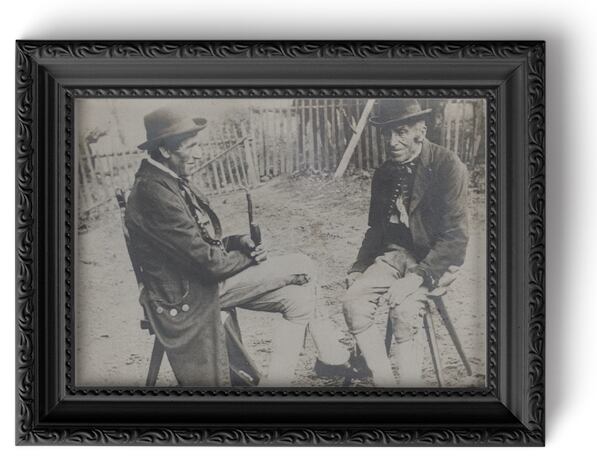
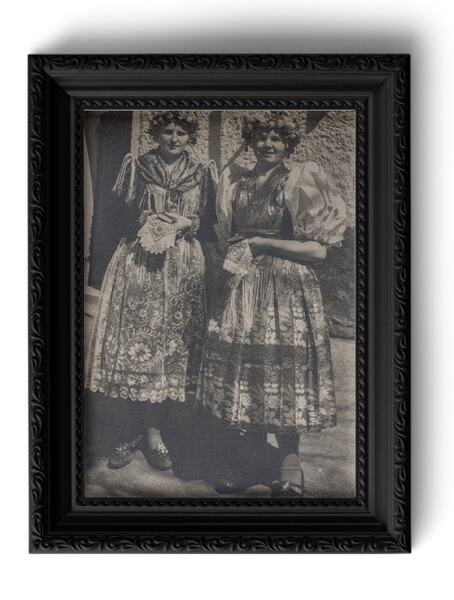
A living tradition – Chod regional kroj
How many people actually wear the traditional folk costume of Chod? My local guides estimate that roughly one in five people wear kroj regularly. They dust it off for the big moments such as christenings and weddings, but also wear it to church on feast days. People put it on for balls, special celebrations, and folk events such as masopust (Fat Tuesday) festivities. Plus, someone points out, it’s comfortable – kroj is made entirely from natural materials and once you’ve put it on, you don’t want to take it off.
There’s also consensus among the little group that as the world becomes more connected, more global, people are discovering a need to ground themselves and rediscover their roots. When I think about it, that may be what really brought me here. Sitting a contemporary, bustling city like Prague, where the streets echo with all the languages of the world, one casts about for something of one’s own.
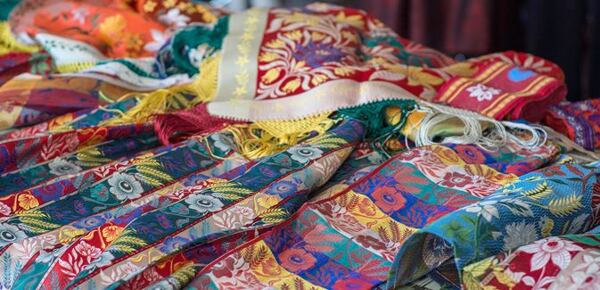
That may also explain the popularity of the many Czechoslovak heritage societies in far-flung corners of the earth. Wherever people go, they like to honor where they came from.
The nuts and bolts – What exactly goes into Chod’s traditional kroj
As a girl from the big city, I was really an outsider here in Postrekov. To my eyes, the local folk costume is made up of a skirt with a few underskirts, some tights, shoes, a white shirt with more or less puffy sleeves, a vest, an apron, a headscarf and a neck scarf. But there’s so much more to it than that.
The underskirt: Spodnicka and vatyrka
At least one cotton slip is worn under the skirt. This is known as spodnicka (SPOHD-neech-kah). Less often seen today is a quilted slip, vatyrka (VAH-teer-kah), that kept the wearer warm and had the added advantage of providing a nice full figure.
The skirt: Serka
The serka (SHARE-kah) was originally made of a special fabric made of flax and wool. The front of the serka is covered by the apron, so more work goes into the back, which is pleated (in the old days it was gathered and the folds stitched in place). The hem is decorated all around with a broad, patterned ribbon. The serka was originally worn ankle-length, but now reaches roughly to the middle of the calf (one of this region’s few nods to the dictates of fashion).

A serka, in traditional crimson, pleated and edged with a silk brocade ribbon
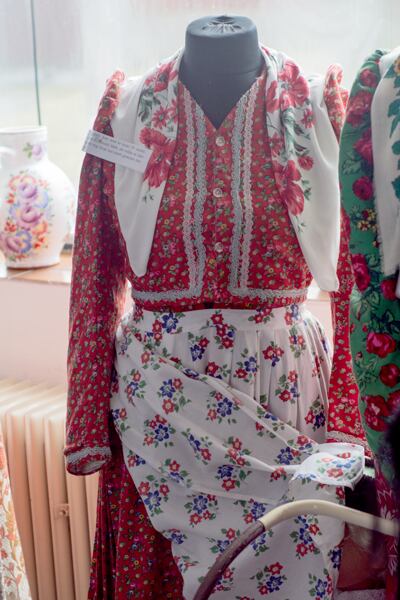
A “dress” consisting of a kandus and matching jupka in wool with a cashmere pattern
the dress: Kandus
An alternative to the serka, the kandus (KAHN-doosh) is a one-piece overall made up of a gently gathered skirt stitched to a simple bodice. Worn with a jacket and a shoulder scarf or head scarf, it makes up a whole outfit that’s very popular among the older generation, who simply call it a “dress.”
The undershirt: Kosile
The white cotton kosile (KOH-shill-eh) is an undershirt with short sleeves that serves to protect the outer layers from sweat stains. It is not visible once one is fully dressed.
The shirtwaist: Rukavce
The shirtwaist, or rukavce (ROO-kahv-tseh), worn over the undershirt is made of white cotton and has big, puffed sleeves. Sleeve length may vary, but they’re always starched.
The ribboned fertoch is also made of a heavy brocade but is characterized by vertical stripes that resemble ribbons with dainty floral patterns.
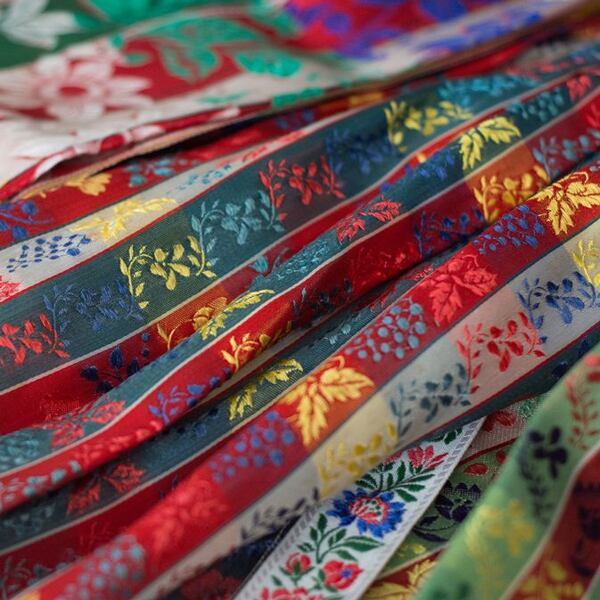
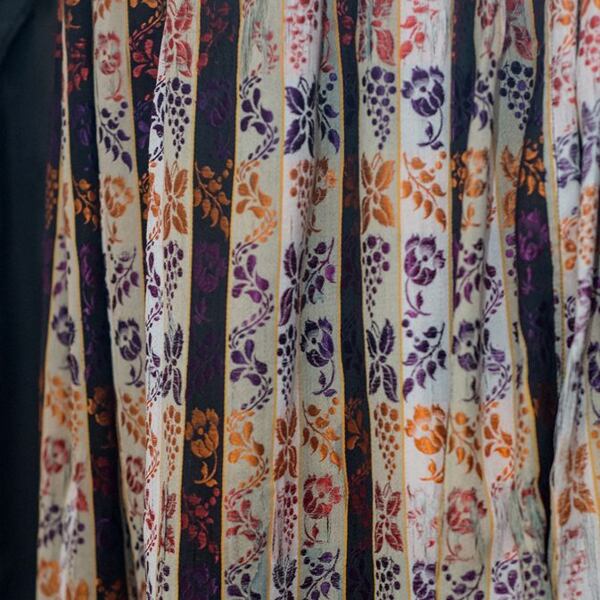

The pattern of the brocade used for a ribboned fertoch looks like dangling ribbons
The apron: Fertoch
The fertoch (FYAIR-tohkh – the last “ch” sounds like the “ch” in the Scottish word “loch”) is an apron tied about the waist. I saw many variations in the museum, many of which are no longer worn because the fabric from which they were made is no longer available.
The striped fertoch, made of wool with strips of gold and multicolored silk in varying widths, is no longer worn in the Chod area, but you may still find them in neighboring Bavaria or nearby Pilsen.
The “cashmere” fertoch is most popular among older ladies. This apron is not actually made of cashmere, but of a light wool twill with a floral print known locally as “cashmere.”
The satin fertoch, dark blue or green with a floral print, was once very popular, but is little seen nowadays. The examples I saw in the little museum appear to be made of cotton in a satin weave.
The brocade fertoch is most popular among wearers of Chod kroj today. The first Chod brocade – with its large flowers and heads of ripe grain – was designed by the Bilek sisters of Mrakov in the 19th century. It was the model for our Bohemian brocade.
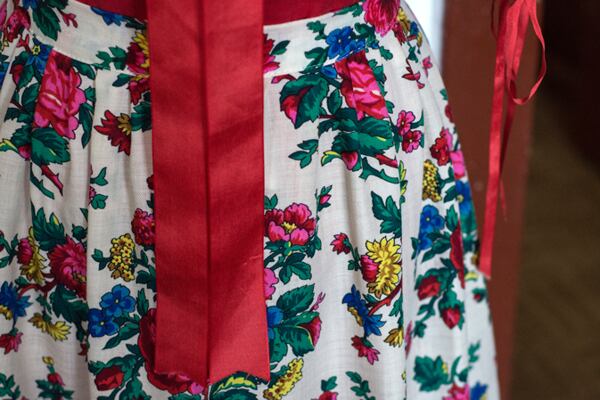
Cashmere fertoch
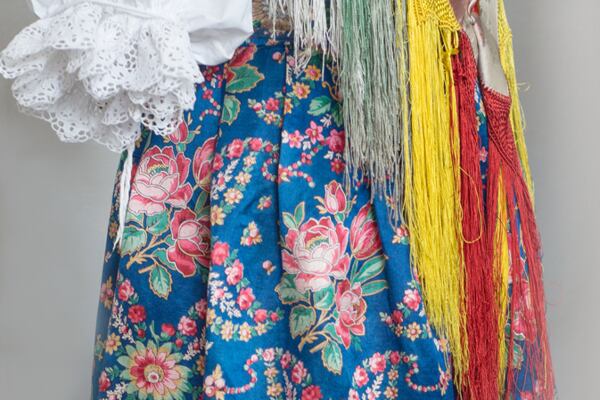
Satin fertoch
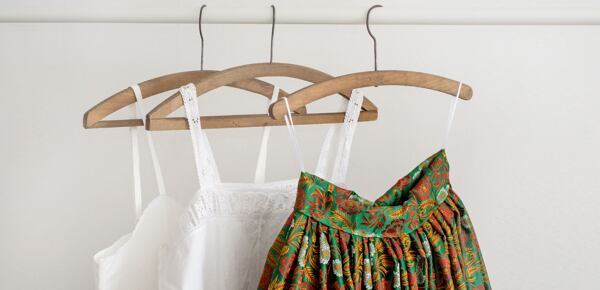
The new Chod kroj brocade by Sartor Bohemia
The vest: Lajblicka or lajblik
The lajblicka (LIE-bleech-kah) or lajblik (LIE-bleek) is a short vest with a scoop neckline made either from a floral brocade or a solid wool broadcloth. The front of the vest is quite simple; all of the fancy ornamentation is reserved for the back (beads, stones, danglers, and sequins). What surprised me was that the gaudy back of the vest is actually hidden from view by a large scarf worn over the shoulders, as though the prim matrons of Chod wanted to hide their wild side.
Sewn to the bottom edge of the vest are thick, padded rolls called jelito (YEH-lee-toh), the Czech word for a sort of pork sausage, which they resemble. They help keep the red outer skirt of the kroj in place.
The jacket: Rozplasenka or jupka
The short, tailored jacket worn with a kandus is known as a rozplasenka (ROSE-plahsh-en-kah) in upper Chod and as a jupka (YOOP-kah) in lower Chod. It fastens up to the neck.
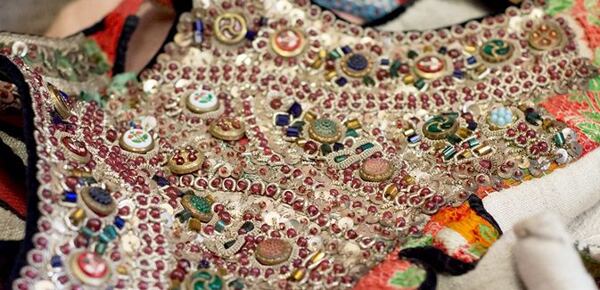
A richly ornamented lajblik with decorative buttons

A rozplasenka or jupka made of brocade
Scarves
I saw three types of scarf in the museum. All are square and range from 80 to 120 cm (about 2 ½ to 4 feet). For an important event, the scarf may be embellished with long tassels. There are embroidered black scarves with tassels made of a cotton satin. There are the “cashmere” scarves, similar to the “cashmere” fertoch described above, made of a fine wool twill with a floral print. And then there are the popular brocade scarves, with or without a broad, blanked border all around.

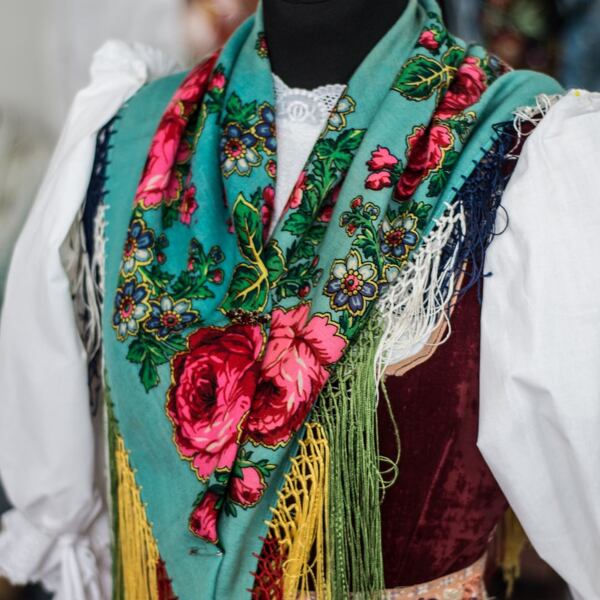

Embroidered black scarves with fringe (left), a cashmere scarf (middle), and brocade scarf with border and fringe (right)
The headdress: Cepeni
A bride and her maids may wear a headdress called a cepeni (CHEP-en-ee). It’s essentially a wreath decorated with so many flowers, bits of mirror, dongles, and sequins, that it looks like one of bathing beauty Esther Williams’s famous swim caps gone berserk.
The shawl: Salup
Even with all of those layers, a girl can get cold. That’s when a salup (SAH-loop) comes in handy. The salup is a square-shaped wool blanket that’s worn over the shoulders.
Ribbons and bows
No kroj would be complete without a liberal dose of colorful jacquard ribbons. There are narrow ribbons (1 3/8"), usually with a white background, that are used almost exclusively in children’s folk costumes. The broader ribbons (2 1/8") used in adult costumes usually also have a white background, though they also come in red. Then there are broad ribbons (2 7/8") used along the hem line; these usually have a red or blue background.

Current trends
Yes, you read that right. As strange as it may seem to speak of “current” trends in traditional regional dress, there’s no denying that they exist in the Chod region. After all, this is a living tradition. Here are the types of kroj that are trending today.
Shirtwaist kroj
Known in Czech as rukavcovy kroj, this is probably the most widespread option worn today. You’ll see it at dances, festivals, and county fairs. It’s a showy costume with wide, starched sleeves. It includes the kosile, rukavce, lajblicka, a pleated serka, and of course underskirts.
Serkovy kroj
This folk costume was once quite common. Today it is a favorite with folk history groups and is also worn for special occasions. It is sometimes referred to as “big kroj.” Serkovy kroj includes rukavce and lajblik with jelito pads sewn at the bottom to keep up the red serka, for which it is named. A fertoch is worn with it, as are red tights, black shoes, a neckscarf and a headscarf.
Pennant kroj
Pennant kroj is made up of a crimson kandus with a jacket worn over it. The bright red material is known locally as “pennant.” The story goes that at the time of the Second World War, when the Chod area was occupied by Germany, local seamstresses scavenged the bright red fabric for this kroj from Nazi flags (though tradition has it that this type of kroj pre-dates the war).
black wedding kroj
Of course, there was also a traditional kroj worn for wedding celebrations in the Chod region. But would you have guessed that the bride wore black? The wedding, while celebrated as a milestone for the young bride and groom, was also a somber occasion for the bride’s family, who were losing a daughter. Wedding kroj in upper Chod was black, in lower Chod blue-black, with a white tulle fertoch and neck scarf, red tights, black shoes, and a black headscarf.
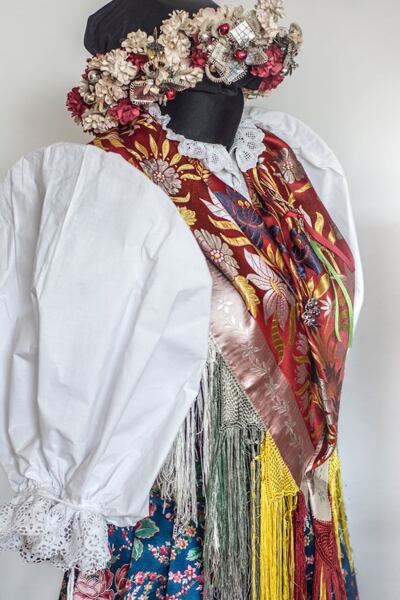
Shirtwaist kroj with its characteristic puffed, starched sleeves, a satin fertoch, brocade scarf with fringe, and cepeni headdress
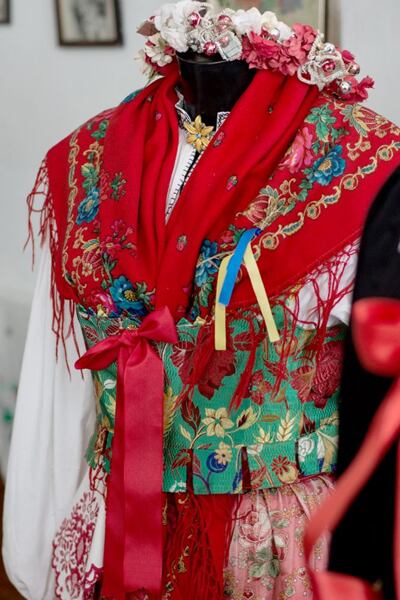
Prastkovy kroj bridesmaid dress from Horni Chodsko with long sleeves, silk fertoch, brocade lajblik, cashmere scarf, and cepeni headdress
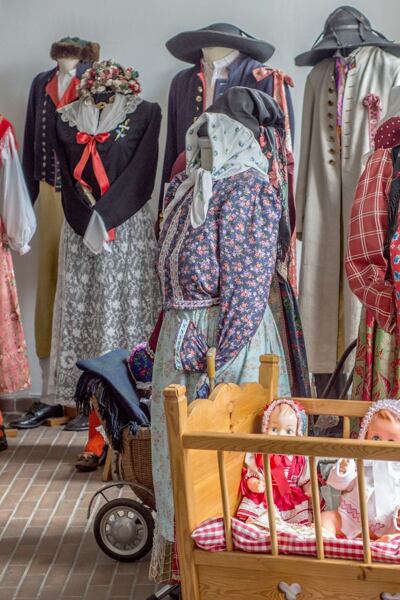
Somber black wedding kroj with its white, tulle fertoch (second from left)
Traditional celebrations call for traditional kroj
If you have roots in the Chod region, and you’re considering dressing in kroj for a special occasion, you may be able to borrow a full costume from a relative or friend in the area or simply rent it…. Kroj is a precious hand-crafted costume and is often passed on from generation to generation. If you decide to dive into making your own, prepare yourself for a serious long-term project. Your skill and perseverance will be rewarded with something you can share with your own children and generations to come.
If you happen to be in the Chod area in August make sure to stop in the village of Domazlice for Chod’s annual folk festival. You’re guaranteed to see plenty of beautiful kroj there both among performers and attendees.
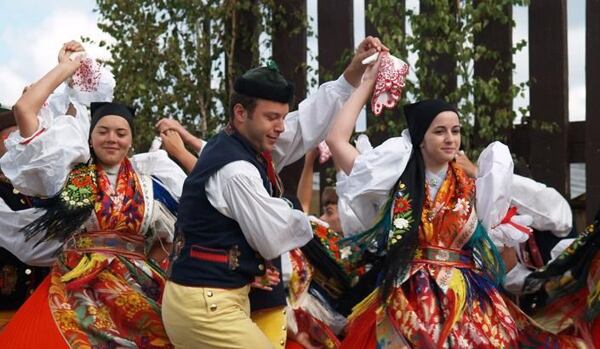
Thanks
This report from the Chod region would never have been possible without the boundless enthusiasm and valuable guidance of the local women who man the front lines, preserving their family treasures and keeping the tradition alive… and who graciously opened the museum in Postrekov to me on the Sunday morning after a village dance that went well into the wee hours. Thanks are also due to Denise Drahonska of the Chod heritage association who helped arrange my visit and to Marie Kopecka, whose dedication and endless patience in working with us to reconstruct the Chod pattern for our Bohemian brocade brought the fabric to life again for use in a new generation of fertochs. It was she who turned our gaze to Chod in the first place. And last, but not least, thanks to Marie Langova, an experienced veteran seamstress of Chod’s regional kroj, who remembers much, knows even more, and was able to answer every question I could come up with. Ladies, our hats come off to you!
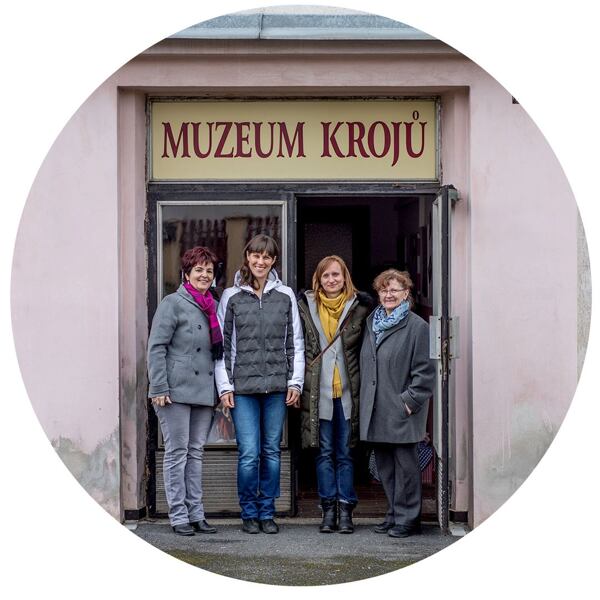
In front of the museum of folk costumes in Postrekov (left to right) Marie Kopecka, Marcela Marin from Sartor, Denisa Drahonska, Marie Langova



Comments(0)